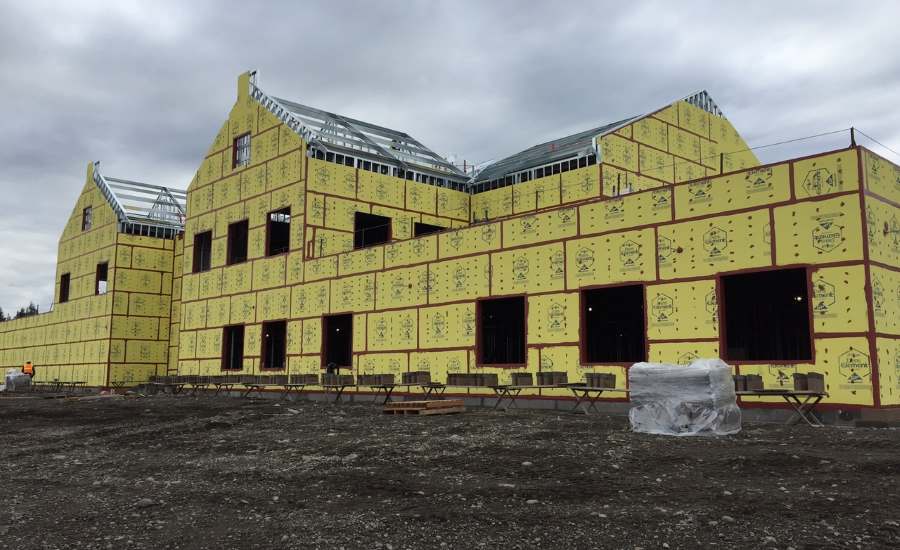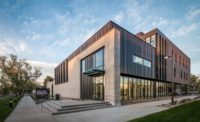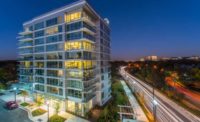Designing for Cold Weather Requires Special Considerations
Don’t Let Winter Put a Freeze on Your Building Envelope

Cold weather regions pose unique challenges for architects and construction crews alike. Freezing temperatures and precipitation can lead to problems that harm both the structural integrity of the building envelope and the comfort of its occupants. Consequently, architects must take a variety of factors into consideration when drawing up plans and selecting materials for the building envelope, and construction crews need to take steps to ensure severe weather doesn’t cause costly delays. But with the proper considerations during both the planning and building phases, projects stakeholders can help ensure they create a building that will withstand the elements both on time and on budget.
Let’s start with the planning phase. Some in the AEC community feel that cold weather climates demand a vapor-impermeable water-resistive and air barrier (WRB-AB) as a component of the building envelope, but that isn’t actually the case. While a WRB-AB is necessary to keep the outside elements from making their way inside the building, choosing one that doesn’t allow vapor to escape can have a damaging effect on the health and structural integrity of the envelope.
The laws of physics dictate that moisture flows in specific ways to find equilibrium. It migrates from warm areas to cooler ones, from areas where it is dense to areas where it is sparse, and from areas of high pressure to low-pressure zones. As a result, frigid temperatures outside buildings located in cold-weather regions will create a vapor drive that causes the accumulated warmth and humidity inside a building to try to escape through the exterior walls. When the warm, moist air collects on those cool surfaces, it can condense into liquid water, which can lead to mold and mildew growth, peeling paint, and corrosion on metal assemblies. For this reason, it’s important to specify a WRB-AB that blocks bulk water but allows vapor to pass through, which will help to prevent the problems caused by condensation.
Ice buildup is also a major concern in cold climates. Since water expands as it freezes, ice can cause cracks in the façade and—if water makes its way inside the building envelope—structural damage to the building envelope. Accumulated snow and ice can also lead to thermal bridging, which allows heat to escape from inside the building through the thermal barrier, decreasing its energy efficiency. For these reasons, it’s important to spec a WRB-AB as part of the building envelope that will not only help keep water and cold air out, but also allow vapor to pass through from the interior to the exterior, which can help to help mitigate the problem of ice and snow formation on the outside of the building.
When it comes to the construction phase of any project, the main concern of building owners is that it's completed on time and on budget. Unfortunately, in cold-weather climates, weather can cause major schedule disruptions. Owners who are concerned with having the building occupied as soon as possible will encourage their architects to find solutions that allow for construction to stay on schedule regardless of how bad the weather gets. Consequently, these designers will traditionally specify products that are inherently capable of being applied in cold weather. This includes liquid-applied WRB-ABs that are silicone-based or contain curing enhancers such as anti-freeze additives, self-adhering membranes with “cold-weather adhesives” or bond enhancers, and building wraps.
But even with their special formulations that allow for cold-weather application, these products must be applied within a specific temperature range in order to be effective. They also don’t account for changes such as drops in ambient temperature and ice and snow accumulation on the envelope’s substrate that can occur overnight or due to weather delays—both of which create bond-inhibiting conditions for liquid-applied and self-adhering WRB-ABs, which can create application issues that can cause scheduling delays. For example, self-adhering membranes can require a primer if the temperature is below their application range. And if they’re applied when there is a layer of snow or ice on the sheathing, it can cause the adhesive to become brittle, or the product will bond with the snow or ice instead of the sheathing.
Liquid-applied products flow more slowly in colder weather, reducing their efficacy and changing their curing and absorption profiles, which can affect the thickness of the application layer. While rolling these products on in cold weather is difficult, spraying is even more challenging and can also be dangerous for workers, since the product can atomize and be inhaled or absorbed through the skin. Ultimately, this could make additional coats necessary, which can delay the attachment of cladding and, in turn, the entire project.
To try to mitigate these circumstances and prevent costly delays, contractors often turn to tenting and heating to regulate the temperature around the envelope during the WRB-AB application process. But the cost to rent, erect and tear down the equipment and run the heaters can be exorbitant. On the other hand, sheathing with integrated WRB/ABs can be applied in cold weather conditions and remain exposed for longer durations, helping to alleviate concerns regarding temperature fluctuation and exposure to ice and snow.
Since these integrated systems only require sealing of the joints, fasteners, openings, penetrations and transitions with a liquid flashing membrane that can be applied to damp surfaces, they can be installed in cold, wet conditions, helping to keep weather delays to a minimum. This makes them an ideal solution for architects who know they need to specify a WRB-AB that can stand up to frigid conditions. And integrated sheathing solutions don’t require additional products such as primers or special preparation for application in cold weather. They can be installed without tenting and heating, and without worry about proper adhesion or coating thickness.
Cold weather climates present challenges for both architects and contractors, which is why taking the proper steps during both the design and construction process is so important. To ensure the long-term health of the building envelope, architects need to feel confident that the WRB-AB they specify can be applied smoothly and effectively in frigid conditions and will do an effective job of protecting the building envelope throughout its lifetime. In short, choosing the right high-performance WRB-AB system will help ensure the project is finished both on time and on budget, and that the final product is a building capable of withstanding the elements while keeping occupants both safe and comfortable.
Looking for a reprint of this article?
From high-res PDFs to custom plaques, order your copy today!






